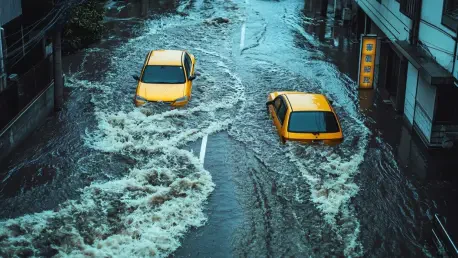Imagine a region battered by relentless monsoon rains, where entire villages are swept away in an instant, leaving hundreds dead and countless others missing, a harrowing reality that has struck northwestern Pakistan. Particularly in Khyber Pakhtunkhwa province, flash floods and landslides have claimed at least 344 lives, drawing global attention to this crisis as rescue efforts struggle against nature’s fury. This roundup gathers diverse perspectives from disaster management officials, climate experts, and international voices to understand the scale of destruction, the challenges of recovery, and the broader implications of such recurring tragedies.
Unpacking the Crisis in Khyber Pakhtunkhwa
Scope of the Catastrophe
Reports from provincial disaster management authorities paint a grim picture of devastation in Khyber Pakhtunkhwa, with 317 of the total 344 fatalities occurring in this region alone. The hardest-hit areas, such as Buner with 208 deaths, have seen entire communities buried under rubble or washed away by raging waters. Updates from local officials highlight the declaration of multiple mountainous districts as disaster zones, signaling an urgent need for coordinated relief.
Insights gathered from ground-level responders emphasize the overwhelming loss of infrastructure. Villages in Shangla and Buner have been described as nearly unrecognizable, with homes, roads, and bridges obliterated. These accounts underscore a critical concern: the sheer scale of destruction complicates any immediate hope for rebuilding, leaving survivors in a state of limbo.
A recurring theme from various regional reports is the emotional toll on affected families. Mass funerals have become a tragic norm, as communities grapple with the loss of loved ones while over 150 individuals remain unaccounted for. This human tragedy, as noted by many local sources, deepens the urgency for swift action and support.
Challenges in Rescue and Recovery Efforts
Feedback from rescue operation leaders reveals the daunting task faced by approximately 2,000 workers across nine districts. Continuous rain and flooded roads have severely hampered access to isolated areas, making it difficult to reach those trapped under debris. Many involved in these efforts express growing concern over diminishing chances of finding survivors.
Despite the obstacles, some progress has been noted by field teams. Restoration of electricity in certain areas marks a small but significant victory amid the chaos. However, damaged infrastructure remains a persistent barrier, with collapsed bridges and blocked pathways slowing down even the most determined rescue missions, as highlighted in operational updates.
Another angle from rescue personnel focuses on the personal risks they face. Working under relentless weather conditions, these teams endure physical and emotional strain while navigating hazardous terrain. Their accounts stress a critical point: without improved resources and better weather forecasting, such operations will continue to face near-impossible odds.
Climate Change: A Driving Force Behind the Disaster
Intensifying Monsoons and Regional Vulnerability
Observations from climate analysts point to a disturbing trend of escalating monsoon intensity in Pakistan, with this year’s rains reported as 50 to 60 percent stronger than those of the prior season. Such data, shared by national disaster authorities, indicates a pattern that could persist through early September, posing further risks to an already vulnerable population.
Broader environmental studies emphasize Pakistan’s high susceptibility to extreme weather events, a factor worsened by global climate change. Since the start of the summer monsoon, over 650 deaths and 920 injuries have been recorded nationwide, reflecting a recurring cycle of destruction. Many researchers argue that this underscores the need for updated disaster preparedness frameworks.
A contrasting view from some policy advocates suggests that while climate change is a key culprit, local governance must also address inadequate infrastructure and urban planning. Their perspective calls for a dual approach—mitigating environmental impacts while bolstering on-the-ground defenses against such natural calamities, a strategy they deem essential for long-term safety.
Global Perspectives on Climate-Driven Crises
International environmental forums have drawn parallels between Pakistan’s plight and other climate-driven disasters worldwide. Commentators note that rising global temperatures are amplifying weather extremes, creating shared challenges across borders. This viewpoint stresses the importance of collaborative efforts to tackle root causes like greenhouse gas emissions.
Some global aid organizations argue that immediate relief must be paired with sustainable solutions. Their input highlights how Pakistan’s recurring floods serve as a call to action for wealthier nations to support climate adaptation in vulnerable regions. Such solidarity, they believe, could set a precedent for addressing similar crises elsewhere.
A differing opinion from economic analysts focuses on the financial burden of recovery. They suggest that while international aid is vital, Pakistan must also invest in self-reliant systems, such as improved early warning technologies. This balance, according to their analysis, could reduce dependency while enhancing resilience against future disasters.
International Solidarity and Support
Responses from Around the World
Voices from the international community reflect deep concern for Pakistan’s current crisis. Offers of aid from nations like Iran demonstrate a willingness to assist with tangible resources, a gesture seen as a lifeline by many local officials. Such support, as noted in diplomatic statements, reinforces the global scope of the disaster’s impact.
Religious and humanitarian leaders have also contributed to the dialogue, with figures like Pope Leo XIV expressing prayers and condolences for the affected. These sentiments, echoed across various platforms, highlight a moral imperative to stand with Pakistan during this trying time, fostering a sense of shared humanity.
A critical perspective from some international NGOs focuses on the long-term implications of such gestures. They argue that while immediate aid is crucial, sustained partnerships are necessary to build capacity against recurring floods. Their recommendations include funding for infrastructure projects and training programs for local disaster response teams.
Comparative Insights on Global Disasters
Analysts comparing Pakistan’s floods to other global events, such as recent hurricanes in coastal regions, note striking similarities in the role of climate change. Their observations suggest that lessons learned from one disaster can inform strategies elsewhere, advocating for a knowledge-sharing network among affected nations.
Another viewpoint from disaster response experts emphasizes the need for standardized protocols in handling climate-driven crises. They point out that while each region faces unique challenges, commonalities in rescue and recovery approaches could streamline efforts. Pakistan’s situation, in their opinion, offers a case study for refining these methods.
A final take from international policymakers centers on funding mechanisms for disaster-prone areas. They propose innovative financial tools, like climate risk insurance, to support countries like Pakistan. This idea, gaining traction in global discussions, aims to provide a safety net that could mitigate the economic fallout of such catastrophes.
Key Takeaways from Diverse Voices
Lessons for Immediate Action
Disaster management officials stress the priority of repairing critical infrastructure to facilitate relief distribution. Their insights reveal that without accessible roads and communication lines, aid cannot reach those in desperate need. This practical focus remains a cornerstone of current recommendations.
Climate advocates, on the other hand, urge the enhancement of early warning systems tailored to remote mountainous areas. Their perspective highlights how timely alerts could save lives, especially in regions prone to sudden floods and landslides. This suggestion aligns with broader calls for technological investment.
A complementary view from community leaders emphasizes grassroots involvement in recovery plans. They advocate for engaging local populations in rebuilding efforts, arguing that such inclusion fosters resilience and ensures solutions are culturally and regionally appropriate. This bottom-up approach adds a vital layer to the discourse.
Encouraging Broader Engagement
Humanitarian groups call for public support in relief initiatives, suggesting contributions to verified organizations working on the ground. Their guidance focuses on channeling resources effectively to address immediate needs like food, shelter, and medical care for survivors in Khyber Pakhtunkhwa.
Policy experts add that advocacy for climate-focused legislation is equally important. They encourage citizens to push for governmental action on environmental protection, viewing public pressure as a catalyst for systemic change. This angle broadens the scope of individual impact beyond direct aid.
A final insight from recovery specialists underscores the value of education on disaster preparedness. They recommend community workshops and school programs to equip residents with survival skills, believing that informed populations are better positioned to withstand future crises. This proactive stance rounds out the array of proposed actions.
Reflecting on a Path Forward
Looking back, the collective insights gathered from various sources paint a sobering picture of the flash flood devastation in northwestern Pakistan. The diverse opinions underscore the multifaceted nature of the crisis, from immediate rescue challenges to the overarching threat of climate change. Each perspective contributes to a deeper understanding of both the human tragedy and systemic vulnerabilities.
Moving forward, actionable steps emerge as a clear priority. Strengthening infrastructure, investing in early warning technologies, and fostering international cooperation stand out as critical measures to mitigate future disasters. Additionally, empowering local communities through education and involvement offers a sustainable way to rebuild resilience.
As a next consideration, exploring innovative funding models like climate risk insurance could provide a financial buffer for vulnerable regions. Coupled with continued global solidarity, these efforts hold promise for transforming recovery into prevention. The dialogue sparked by this crisis serves as a reminder of the shared responsibility to protect at-risk populations and address environmental challenges head-on.









